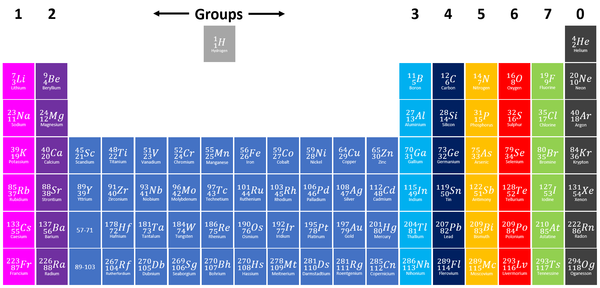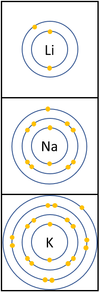Difference between revisions of "Group (Chemistry)"
| Line 4: | Line 4: | ||
===About Groups=== | ===About Groups=== | ||
| + | : [[Helium]], in [[Group 0]] is an exception to this rule as it has 2 [[electron]]s in its [[Outer Shell]]. | ||
: The [[element]]s are arranged '''groups''' of similar [[Chemical Property|chemical properties]]. | : The [[element]]s are arranged '''groups''' of similar [[Chemical Property|chemical properties]]. | ||
: [[Element]]s have similar [[Chemical Property|chemical properties]] when they have the same number of [[electron]]s in the [[Outer Shell]]. | : [[Element]]s have similar [[Chemical Property|chemical properties]] when they have the same number of [[electron]]s in the [[Outer Shell]]. | ||
| Line 11: | Line 12: | ||
|[[File:PeriodicTableGroups.png|center|600px]] | |[[File:PeriodicTableGroups.png|center|600px]] | ||
|} | |} | ||
| − | + | ===Trends within groups=== | |
The [[Chemical Property|chemical properties]] of [[element]]s within a '''group''' are similar. However, the [[reactivity]] within a '''group''' changes as you move up or down the [[Period (Chemistry)|period]]s. | The [[Chemical Property|chemical properties]] of [[element]]s within a '''group''' are similar. However, the [[reactivity]] within a '''group''' changes as you move up or down the [[Period (Chemistry)|period]]s. | ||
*[[Group 1]]: The [[Alkali Metal]]s all react strongly with water. The [[reactivity]] increases as you go down the '''group'''. | *[[Group 1]]: The [[Alkali Metal]]s all react strongly with water. The [[reactivity]] increases as you go down the '''group'''. | ||
| Line 19: | Line 20: | ||
The [[Physical Property|physical properties]] of [[element]]s within a '''group''' are similar. However, the property changes gradually as you move down the '''group'''. | The [[Physical Property|physical properties]] of [[element]]s within a '''group''' are similar. However, the property changes gradually as you move down the '''group'''. | ||
| + | |||
| + | ==Key Stage 4== | ||
| + | ===Meaning=== | ||
| + | A '''Group''' is a column on the [[Periodic Table]] with [[element]]s with the same number of [[electron]]s on the [[Outer Shell]]. | ||
| + | |||
| + | ===About Groups=== | ||
| + | : [[Helium]], in [[Group 0]] is an exception to this rule as it has 2 [[electron]]s in its [[Outer Shell]]. | ||
| + | : The [[element]]s were oringally arranged '''groups''' of similar [[Chemical Property|chemical properties]]. | ||
| + | : It was later discovered that [[element]]s have similar [[Chemical Property|chemical properties]] when they have the same number of [[electron]]s in their [[Outer Shell]]s. | ||
| + | |||
| + | {| class="wikitable" | ||
| + | |- | ||
| + | |[[File:PeriodicTableGroups.png|center|600px]] | ||
| + | |} | ||
| + | ===Trends within groups=== | ||
| + | The [[Chemical Property|chemical properties]] of [[element]]s within a '''group''' are similar. However, the [[reactivity]] within a '''group''' changes as you move up or down the [[Period (Chemistry)|period]]s due to the number of [[Electron Shell]]s. | ||
| + | ====[[Group 1]]: The [[Alkali Metal]]==== | ||
| + | =====Chemical Properties===== | ||
| + | : '''Alkali Metals''' are all highly [[Reactivity|reactive]] and will [[Oxidisation|oxidise]] quickly in the presence of [[Oxygen]]. | ||
| + | : '''Alkali Metals''' all [[Chemical Reaction|react]] strongly with [[water]] to produce [[Metal Hydroxide|metal hydroxides]] and [[Hydrogen]] [[gas]]. | ||
| + | : '''Alkali Metals''' all produce strong [[alkali]]s. | ||
| + | {| class="wikitable" | ||
| + | |- | ||
| + | |[[File:Group1ElectronShells.png|center|100px]] | ||
| + | | style="height:20px; width:500px; text-align:left;" |In a [[Chemical Reaction|chemical reaction]] the [[electron]] in the [[Outer Shell|outer shell]] is lost. | ||
| + | |||
| + | The [[reactivity]] increases as you go down the group because: | ||
| + | *The outer [[electron]] is further away from the [[Atomic Nucleus|nucleus]] with each additional [[Electron Orbital|electron shell]] making the [[force]] of [[attract]]ion weaker. This makes it easier for an [[atom]] to lose it's outer [[electron]]. | ||
| + | *Even though the [[charge]] of the [[Atomic Nucleus|nucleus]] increases the outer [[electron]] is shielded from most of the [[Positive Charge|positive charge]] of the [[Atomic Nucleus|nucleus]] by [[electron]]s in the [[Inner Shell|inner shells]]. | ||
| + | |} | ||
| + | =====Physical Properties===== | ||
| + | : '''Alkali Metals''' have a low [[density]] compared to other [[metal]]s. | ||
| + | : '''Alkali Metals''' are all [[solid]] at [[Room Temperature|room temperature]] but have a low [[Melting Point|melting point]] compared to other [[metal]]s. | ||
| + | : '''Alkali Metals''' are soft and can be easily cut. | ||
| + | : '''Alkali Metals''' all appear shiny (before they [[oxidisation|oxidise]]). | ||
| + | *[[Group 2]]: The [[Alkali Earth Metal]]s all react strongly with steam and acids. The [[reactivity]] increases as you go down the '''group'''. | ||
| + | *[[Group 7]]: The [[Halogen]]s all act as bleaching agents and kill bacteria. The reactivity decreases as you go down the '''group'''. | ||
| + | *[[Group 0]]: The [[Noble Gases]] are all inert (unreactive). | ||
Revision as of 14:16, 5 December 2018
Contents
Key Stage 3
Meaning
A Group is a column on the Periodic Table with elements with the same number of electrons on the Outer Shell.
About Groups
- Helium, in Group 0 is an exception to this rule as it has 2 electrons in its Outer Shell.
- The elements are arranged groups of similar chemical properties.
- Elements have similar chemical properties when they have the same number of electrons in the Outer Shell.
Trends within groups
The chemical properties of elements within a group are similar. However, the reactivity within a group changes as you move up or down the periods.
- Group 1: The Alkali Metals all react strongly with water. The reactivity increases as you go down the group.
- Group 2: The Alkali Earth Metals all react strongly with steam and acids. The reactivity increases as you go down the group.
- Group 7: The Halogens all act as bleaching agents and kill bacteria. The reactivity decreases as you go down the group.
- Group 0: The Noble Gases are all inert (unreactive).
The physical properties of elements within a group are similar. However, the property changes gradually as you move down the group.
Key Stage 4
Meaning
A Group is a column on the Periodic Table with elements with the same number of electrons on the Outer Shell.
About Groups
- Helium, in Group 0 is an exception to this rule as it has 2 electrons in its Outer Shell.
- The elements were oringally arranged groups of similar chemical properties.
- It was later discovered that elements have similar chemical properties when they have the same number of electrons in their Outer Shells.
Trends within groups
The chemical properties of elements within a group are similar. However, the reactivity within a group changes as you move up or down the periods due to the number of Electron Shells.
Group 1: The Alkali Metal
Chemical Properties
- Alkali Metals are all highly reactive and will oxidise quickly in the presence of Oxygen.
- Alkali Metals all react strongly with water to produce metal hydroxides and Hydrogen gas.
- Alkali Metals all produce strong alkalis.
| In a chemical reaction the electron in the outer shell is lost.
The reactivity increases as you go down the group because:
|
Physical Properties
- Alkali Metals have a low density compared to other metals.
- Alkali Metals are all solid at room temperature but have a low melting point compared to other metals.
- Alkali Metals are soft and can be easily cut.
- Alkali Metals all appear shiny (before they oxidise).
- Group 2: The Alkali Earth Metals all react strongly with steam and acids. The reactivity increases as you go down the group.
- Group 7: The Halogens all act as bleaching agents and kill bacteria. The reactivity decreases as you go down the group.
- Group 0: The Noble Gases are all inert (unreactive).

